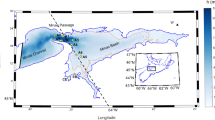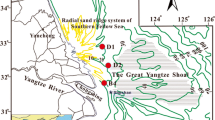Abstract
Sediment resuspension is commonly assumed to be eroded from the seabed surface by an excess bottom shear stress and evolves in layers from the top down. Although considerable investigations have argued the importance of wave-induced seabed fluidization in affecting the sediment resuspension, few studies have been able to reliably evaluate its quantitative contribution till now. Attempt is made to preliminarily quantify the contribution of fluidization to resuspension using a series of large-scale wave flume experiments. The experimental results indicated that fluidization of the sandy silts of the Huanghe Delta account for 52.5% and 66.8% of the total resuspension under model scales of 4/20 and 6/20 (i.e., relative water depth: the ratio of wave height to water depth), respectively. Some previously reported results obtained using the same flume and sediments are also summarized for a contrastive analysis, through which not only the positive correlation is confirmed, but also a parametric equation for depicting the relationship between the contribution of fluidization and the model scale is established. Finally, the contribution of fluidization is attributed to two physical mechanisms: (1) an attenuation of the erosion resistance of fluidized sediments in surface layers due to the disappearing of original cohesion and the uplifting effect resulting from upward seepage flows, and (2) seepage pumping of fines from the interior to the surface of fluidized seabed.
Similar content being viewed by others
References
Bennett R H. 1977. Pore-water pressure measurements: Mississippi delta submarine sediments. Marine Geotechnology, 2(1–4): 177–189
Bennett R H, Faris J R. 1979. Ambient and dynamic pore pressures in fine-grained submarine sediments: Mississippi Delta. Applied Ocean Research, 1(3): 115–123
Biron P M, Robson C, Lapointe M F, et al. 2004. Comparing different methods of bed shear stress estimates in simple and complex flow fields. Earth Surface Processes and Landforms, 29(11): 1403–1415
Bolaños R, Thorne P D, Wolf J. 2012. Comparison of measurements and models of bed stress, bedforms and suspended sediments under combined currents and waves. Coastal Engineering, 62: 19–30
Bornhold D B, Yang Z S, Keller G H, et al. 1986. Sedimentary framework of the modern Huanghe (Yellow-River) Delta. Geo-Marine Letters, 6(2): 77–83
Clukey E C, Kulhawy F H, Liu P L F, et al. 1985. The impact of wave loads and pore-water pressure generation on initiation of sediment transport. Geo-marine letters, 5(3): 177–183
Danielsson Å, Jönsson A, Rahm L. 2007. Resuspension patterns in the Baltic proper. Journal of Sea Research, 57(4): 257–269
Green M O. 1992. Spectral estimates of bed shear stress at subcritical Reynolds numbers in a tidal boundary layer. Journal of Physical Oceanography, 22(8): 903–917
Green M O, Coco G. 2014. Review of wave-driven sediment resuspension and transport in estuaries. Reviews of Geophysics, 52(1): 77–117
Grant W D, Madsen O S. 1979. Combined wave and current interaction with a rough bottom. Journal of Geophysical Research: Oceans, 84(C4): 1797–1808
Guo Lei, Wen Mingzheng, Shan Hongxian, et al. 2016. Study on resuspension process of seabed sediment induced by wave. Marine Geology & Quaternary Geology (in Chinese), 36(5): 181–188
Jeng D S, Ye J H, Zhang J S, et al. 2013. An integrated model for the wave-induced seabed response around marine structures: model verifications and applications. Coastal Engineering, 72: 1–19
Jia Yonggang, Zhang Liping, Zheng Jiewen, et al. 2014. Effects of wave-induced seabed liquefaction on sediment re-suspension in the Yellow River Delta. Ocean Engineering, 89: 146–156
Kim S C, Friedrichs C T, Maa J P Y, et al. 2000. Estimating bottom stress in tidal boundary layer from acoustic doppler velocimeter data. Journal of Hydraulic Engineering, 126(6): 399–406
Lambrechts J, Humphrey C, McKinna L, et al. 2010. Importance of wave-induced bed liquefaction in the fine sediment budget of Cleveland Bay, Great Barrier Reef. Estuarine, Coastal and Shelf Science, 89(2): 154–162
Mörz T, Karlik E A, Kreiter S, et al. 2007. An experimental setup for fluid venting in unconsolidated sediments: new insights to fluid mechanics and structures. Sedimentary Geology, 196(1): 251–267
Nichols R J, Sparks R S J, Wilson C J N. 1994. Experimental studies of the fluidization of layered sediments and the formation of fluid escape structures. Sedimentology, 41(2): 233–253
Nielsen P. 2002. Shear stress and sediment transport calculations for swash zone modelling. Coastal Engineering, 45(1): 53–60
Nielsen P, Robert S, Møller-Christiansen B, et al. 2001. Infiltration effects on sediment mobility under waves. Coastal Engineering, 42(2): 105–114
Paphitis D, Collins M B. 2005. Sediment resuspension events within the (microtidal) coastal waters of Thermaikos Gulf, northern Greece. Continental Shelf Research, 25(19): 2350–2365
Ross J A, Peakall J, Keevil G M. 2011. An integrated model of extrusive sand injectites in cohesionless sediments. Sedimentology, 58(7): 1693–1715
Saito Y, Yang Zuosheng, Hori K. 2001. The Huanghe (Yellow River) and Changjiang (Yangtze River) deltas: a review on their characteristics, evolution and sediment discharge during the Holocene. Geomorphology, 41(2): 219–231
Seed H B, Rahman M S. 1978. Wave-induced pore pressure in relation to ocean floor stability of cohesionless soils. Marine Geotechnology, 3(2): 123–150
Soulsby R. 1997. Dynamics of Marine Sands. London: Thomas Telford, 249
Sumer B M, Kirca V S O, Fredsøe J. 2012. Experimental validation of a mathematical model for seabed liquefaction under waves. International Journal of Offshore and Polar Engineering, 22(2): 133–141
Tzang S Y. 1998. Unfluidized soil responses of a silty seabed to monochromatic waves. Coastal Engineering, 35(4): 283–301
Tzang S Y, Ou S H, Hsu T W. 2009. Laboratory flume studies on monochromatic wave-fine sandy bed interactions: Part 2. Sediment suspensions. Coastal Engineering, 56(3): 230–243
van Duin E H S, Lijklema L. 1989. The development of an operational two-dimensional water quality model for Lake Marken, the Netherlands. Water Science & Technology, 21(12): 1817–1820
Van Raaphorst W, Malschaert H, Van Harren H. 1998. Tidal resuspension and deposition of particulate matter in the Oyster Grounds, North Sea. Journal of Marine Research, 56(1): 257–291
Wang Y H. 2003. The intertidal erosion rate of cohesive sediment: a case study from Long Island Sound. Estuarine, Coastal and Shelf Science, 56(5): 891–896
Wolanski E, Spagnol S. 2003. Dynamics of the turbidity maximum in King Sound, tropical Western Australia. Estuarine, Coastal and Shelf Science, 56(5): 877–890
Wright L D, Friedrichs C T, Kim S C, et al. 2001. Effects of ambient currents and waves on gravity-driven sediment transport on continental shelves. Marine Geology, 175(1): 25–45
Xu Guohui. 2006. Study on the landslide of gentle-slope silty seabed under waves: a case of the Yellow River Subaqueous Delta (in Chinese) [dissertation]. Qingdao: Ocean University of China
Xu Guohui, Liu Zhiqin, Sun Yongfu, et al. 2016. Experimental characterization of storm liquefaction deposits sequences. Marine Geology, 382: 191–199
You Zaijin. 2005. Fine sediment resuspension dynamics in a large semi-enclosed bay. Ocean Engineering, 32(16): 1982–1993
Yuan Ye, Wei Hao, Zhao Liang, et al. 2009. Implications of intermittent turbulent bursts for sediment resuspension in a coastal bottom boundary layer: a field study in the western Yellow Sea, China. Marine Geology, 263(1): 87–96
Ye Jianhong. 2012. 3D liquefaction criteria for seabed considering the cohesion and friction of soil. Applied Ocean Research, 37: 111–119
Zhang Shaotong, Jia Yonggang, Guo Lei, et al. 2016a. In-situ observation of sediment deposition process in Chengdao sea area of the Yellow River estuary. Marine Geology & Quaternary Geology (in Chinese), 36(3): 171–181
Zhang Shaotong, Jia Yonggang, Liu Xiaolei, et al. 2016b. Feature and mechanism of sediment dynamic changing processes in the modern Yellow River Delta. Marine Geology & Quaternary Geology (in Chinese), 36(6): 33–44
Zhang Shaotong, Jia Yonggang, Wen Mingzheng, et al. 2017. Vertical migration of fine-grained sediments from interior to surface of seabed driven by seepage flows-"sub-bottom sediment pump action". Journal of Ocean University of China, 16(1): 15–24
Zhang Shaotong, Jia Yonggang, Zhang Yaqi, et al. 2018. Influence of seepage flows on the erodibility of fluidized silty sediments: parameterization and mechanisms. Journal of Geophysical Research: Oceans: doi: 10.1002/2018JC013805
Acknowledgments
The authors thank Xu Jingping, Liu Hongjun, Xu Guohui, Wang Hu, Guo Lei and Li Hongjiang for their constructive suggestions. Wang Weihong, Li Bowen, Han Chichen, Wang Xiaoqiong, Tang Huiling, Wang Siyu and Ruan Meimei from the Ocean University of China, are acknowledged for their contributions to the experimental campaign and logistic support.
Author information
Authors and Affiliations
Corresponding author
Additional information
Foundation item: The National Natural Science Foundation of China under contract Nos 41272316 and 41372287; the Joint Fund of NSFC and Marine Science Research Centers of Shandong Province of China under contract No. U1606401; the Key Research and Development Program of Shandong Province of China under contract No. 2016ZDJS09A03.
Rights and permissions
About this article
Cite this article
Zhang, S., Jia, Y., Wang, Z. et al. Wave flume experiments on the contribution of seabed fluidization to sediment resuspension. Acta Oceanol. Sin. 37, 80–87 (2018). https://doi.org/10.1007/s13131-018-1143-2
Received:
Accepted:
Published:
Issue Date:
DOI: https://doi.org/10.1007/s13131-018-1143-2




